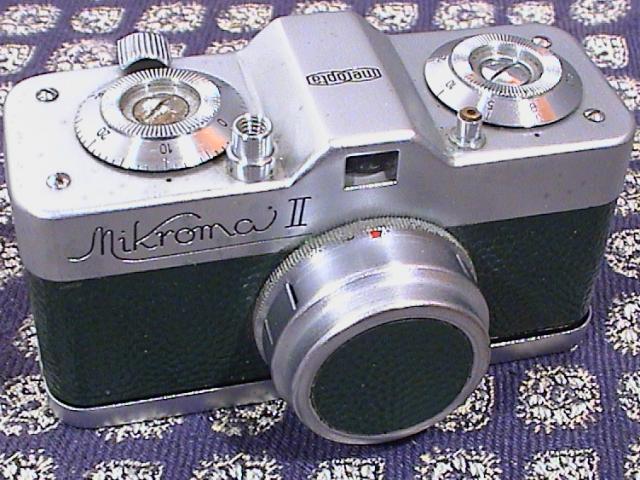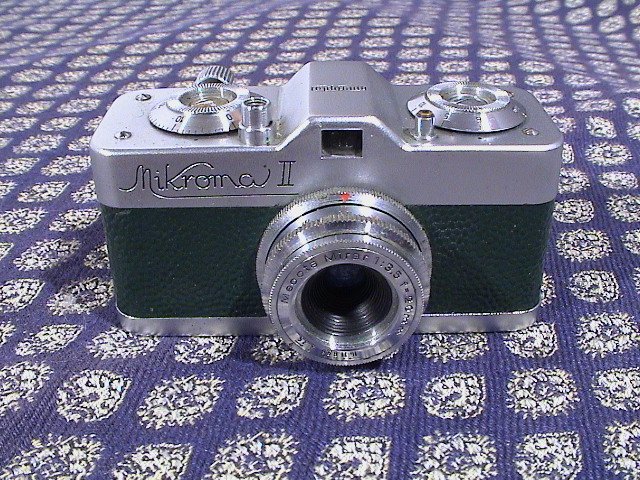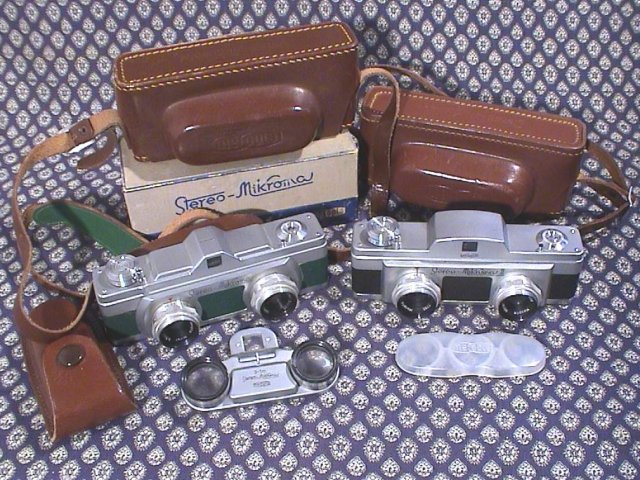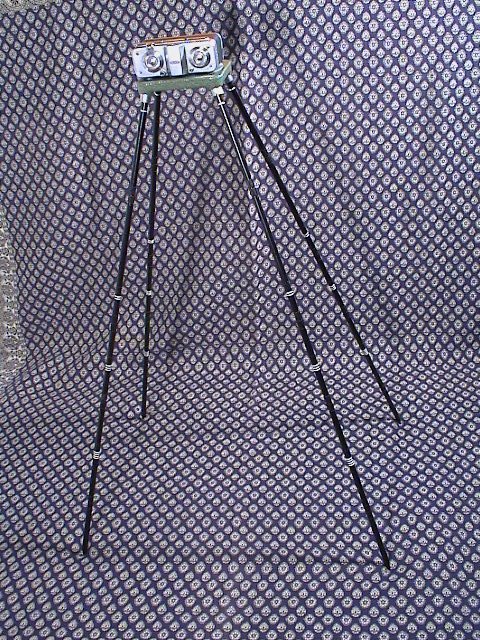introduction |
Mikronette |
Mikronette
stereo
I |
Optikotechna Mirar
black | black |
black
fine grain |
black enamel |
black police |
brown |
brown
snake skin |
gold
| green |
red
| spy - fixed focus |
stereo black |
stereo green |
II |
beige |
black |
black fine grain |
brown |
green (early version) |
green (later version) |
light green |
yellow
| special |
stereo black |
stereo green
The beginning of Meopta lies in the year 1933. At that time, the production plant Optikotechna was founded in Prerov by Dipl. Ing. Benes. Since that time, the optico-mechanical production in Prerov has passed through a long development and Meopta's products found their way to many countries worldwide. See http://www.meopta.cz/history/products/History.html for more details.

1933 - Dipl.Ing. Alois Benes established company Optikotechna in Prerov. Dr. Mazurek constructed the first Czechoslovak enlarging lens.
1934-1937 - Optikotechna focused on darkroom equipment (mainly enlargers and lenses).
1937 - Optikotechna built new facilities for production in suburb of Prerov.
1939-1945 - Optikotechna was forced to supply military optical equipment for German army (rangefinders, periscopes, binoculars, riflescopes). Optikotechna was renamed to "Herrmann Goering Optische Verzeuge".
1946 - Optikotechna renamed to Meopta national enterprise.
1947-1970 - Meopta became one of the biggest enlarger manufacturers worldwide and the only cinema projector manufacturer in Central/East Europe.
1953 - The Institute for Research and Development of Optics and Precision Mechanics was established in Prerov.
1971 - There was a rapid increase of military production for Warsaw Pact (up to 75% of total turnover).
1988 - Meopta renewed riflescopes production, decreasing military production.
1990 - Meopta military programme decreased to 0%, Meopta Prerov, a.s became separate subsidiary join stock companies.
1992 - Meopta is fully privatised and remains the only optical enterprise in Czech Republic. Became a supplier of major optical companies worldwide.
Cameras
This is one of smallest cameras that in fact looks like camera. It was made by Meopta in Prerov in former Czechoslovakia.
Mikroma 16mm format cameras can trace their origins back to the pre-war Optikotechna factory. The first model was called the Mikronette, designed for military use capable of making 240 exposures. The Mikroma of 1949 used 16mm single perforated film to produce a negative of 11x14mm. Speeds of 1/25-1/200 and a 20mm Mirar (f3.5-16) focusing lens.

The shutter release, shutter cocking and film advance functions were all built into one sliding l lever on the top back of the camera. Pushing it once took the picture. Pushing it again advanced the film and cocked the shutter. In later models, these functions would be split out.
Mikroma cameras were available in black, brown and green body covering. An all black police version of the Mikroma I, presumably for the Czech police, was finished in black enamel included a waist level finder not found on the standard models. There was also a limited number of gold cameras.
The Stereo Mikroma was designed in 1960 and resembles a stretched Mikroma with a second lens added. The shutters speeds lengthened to B, 1/5 - 1/100 and the fixed lenses are two three-element Mirar 25mm lenses with apertures from f3.5 - 16. The f-stop settings are cross-linked to help avoid exposure errors. The stereo model has a standard shutter release, the lever on the back cocks the shutter and the film is advanced by a large knob on the top. The two images are 12x13mm. Special snap-on close-up filter set for use up to 1-60cm and 3-1m include a viewfinder with parallax adapter. They also made a special film cutter and a stereo viewer. It's obviously fairly large and weights in at 500 grams but gives excellent results.
The Mikroma II came out about 1957 (according to SubClub.org, 1964 according to Spy Camera). In the book "fotografujeme s Mikromou" ("We are taking pictures with Mikroma") there is a picture of Mikroma II on the title page. The book was given to print on 27th November 1958, and must be written some time prior. With printing taking one half to a whole year under communism would indicate a 1957 date for the release of the camera. There are some indication that Mikroma II prototypes do exist from the end of 1955 but can not confirm by Meopta. The company lost, during a flood, part of archive and now it is a private company and not open to people researching it history.
The improvements in the Model II included shutter speeds from 1/5th to 1/400th and a more conventional film advance system was incorporated. These are separated and the camera has a normal shutter release button. See the models compared. At some point the film advance slider was changed from the original Mark I type reducing the profile. More accessories were made available; including filters, close-up adapters, a copy stand, film cutting and viewing devices, a 30x30mm slide projector, an enlarger, and a developing tank.
The following variations in Meopta Mikroma cameras have been seen:-
- Mikronette - long roll camera - somewhat similar to the Leica 250 Reporter model.
- Mikronette stereo black - long roll camera - similar to the Leica 250.
- black
with lens marked Optikotechna Mirar
with lens marked Meopta Prerov Mirar serial numbers 43195 to 435070
with lens marked Meopta Mirar serial number 434817 to 4314878 - black enamel - non-Police model.
- black police - black enamel spy camera from the dreaded Czech Secret Policemen
- brown
- brown snake skin
- gold Apparently several were made for presentation to Communist officials.
- green
- red
- spy - fixed focus There is no focusing feature on this cameras lens.
- stereo black The basic camera made into a "double" camera.
- stereo green
- II black
- seem to be more rare than green variations
with lens marked Meopta Mirar serial number 14571 to 10112744
and two forms of the shutter release bar - II green (early version) (two variations on the film advance slide bar and a light and dark green)
- II green (later version)
- II light green some refer to as beige - pale sandy colour - It appears to be quite scarce.
- II special edition Mikroma II green
- II stereo black
- II stereo green
- II stereo brown
Collecting the models can be quite a "challenge." rreinke@charter.net

Models Compared
Accessories
- Boxes
- Cases
- Close up lens
- Copy Stand
- Developing Tank
- Endoscope
- Enlargers
- Exposure meter
- Film
- Film/slide Cutters
- Filters and attachments
- Projectors
- Slide frames
- Slide Viewers
- Stereo macro/close-up lens
There are a number of accessories for the Mikroma camera family. Most were introduced with the Mikroma II.

